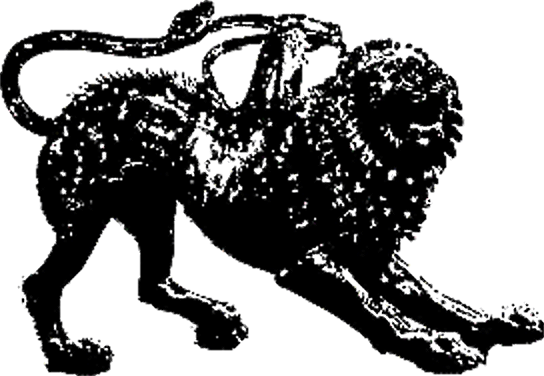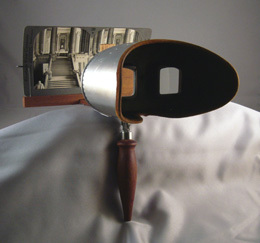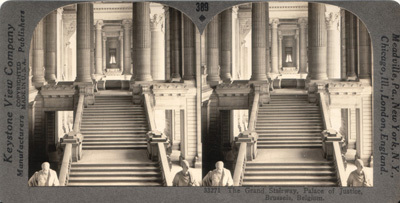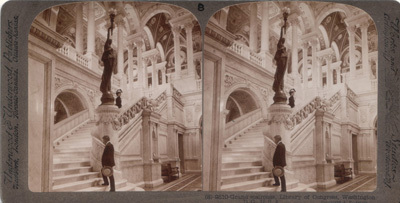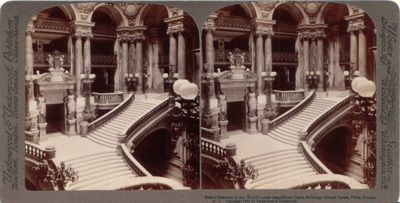No section
Douglas Klahr (Arlington)
Stereoscopic Photography Encounters the Staircase
Traversing Thresholds, Borders and Passages
urn:nbn:de:0009-21-35992
Interfaces between the Staircase and the Stereoview
The topic of thresholds, boundaries and passages not only suggests an emphasis upon the three-dimensional quintessence of architecture, but also the fourth dimension of time as measured when one traverses thresholds, boundaries and passages. When architectural components are considered, doors and windows first come to mind, but the time element is limited by their planar character: going through a door or window is usually a short moment in time. If one considers space, the time taken to traverse a space is longer, but the notions of threshold and boundary become weaker. Walls, ceilings and floors boldly announce thresholds and boundaries, but going through them is not a routine activity for human beings who lack supernatural powers, thereby mitigating the elements of passage and time. A question then arises: what architectural component most potently embodies thresholds, boundaries and passages as well as their underlying characteristic of time? A logical answer would be the staircase, and that is the focus of this essay, which concentrates upon internal staircases.
Staircases within buildings confound architectural thresholds and boundaries starting with their most obvious characteristic: their diagonal orientation as they progress from one level to the next. This challenges notions of walls, ceilings and floors as well as the scope of human movement: when other than on a staircase does one's body move in a diagonal direction through space? If one develops this thought other transgressions arise: concepts of beginning/end, here/there, and in/out are extraordinarily fluid within staircases. In essence, staircases are perhaps the best example of intermediary zones within buildings, quantified not only by the aspects noted above, but also by their raison d'ĂȘtre: to provide passage between levels of a structure. The notion of passage therefore remains very potent within a staircase, and passage once again returns us to the dimension of time.
This introduces the lens through which staircases are examined in this essay: the time-dependent medium of stereoscopic photography. With the invention of stereoscopic photographs in the second half of the Nineteenth Century, a major threshold was crossed regarding two-dimensional representations of three-dimensionality. Jean Clair observed that stereoscopic photography embodied a "dialectical reversal." In contrast to perspective, which "consisted in reducing the three-dimensional to the two dimensions of a stretched canvas", as does non-stereoscopic photography, Clair noted that stereoscopic photography "allowed one to obtain a purely tri-dimensional configuration." [1] The dynamics – and time element – of stereoscopy reside in the constantly shifting perceptions of depth that are part of the ocular-neuronal exercise necessary on the part of the viewer, most often using the so-called Holmes stereoscope.
Holmes Stereoscope. Photograph by author, collection of author. Manufactured by Underwood & Underwood c. 1901, this is a pristine, museum-grade example of a Holmes-style stereoscope.
When the intermediary zone of a staircase is examined through this medium, borders, thresholds, passages and time interface with one another in a particularly rich matrix. [2]
In a 1982 essay, Rosalind Krauss wrote about the stereoscopic experience:
"Organized as a kind of tunnel vision, the experience of deep recession is insistent and inescapable. The experience is all the more heightened by the fact that the viewer's own ambient space is masked out by the optical instrument he must hold to his eyes […] The actual readjustment of the eyes from plane to plane within the stereoscopic field is the representation of one part of the body of what another part of the body, the feet, would do in passing through real space." [3]
The kinesthetic eye-foot connection that Krauss makes is important for understanding how stereoscopy embodies a threshold between actual and virtual experience. As human beings, our routine means of movement through space is by our legs and feet. A stereoview is a series of receding planes that creates a virtual sense of depth that often is more intense than an actual experience due to this multi-planar aspect. Certain subjects – notably human beings – often appear excessively planar, due to clothing that camouflages the contours of torsos and limbs. [4] In many instances, the viewer becomes acutely aware of this planarity, and one's eyes shift and refocus in a manner that is different than when one is shifting one's focus in an actual space. In a sense, a viewer's eyes mimic footsteps, not in the literal sense of moving forward but in a series of discrete, separate movements.
This eye-foot connection intensifies when a particular form of human movement occurs: climbing up or down a staircase. In his study about stairways, Hans Weidinger begins by referencing Friedrich Mielke's Handbuch der Treppenkunde. Mielke wrote that the "ambience of climbing stairs is important. One climbs, of course, with the legs, but is guided by the eyes." Weidinger then continues with his own thought: "Movement in the staircase is thus not merely a motor action. As in a film, our optical awareness jumps from long-range to a close-up and back again." [5] Traversing a staircase involves eye-foot coordination to a greater extent than merely walking due to mastering the riser-tread combination, thereby blurring the boundaries between vision and bipedal motion. Weidinger makes an analogy between traversing a staircase to film, but a cinema spectator has no choice but to accept the film director's decisions about image sequence. By contrast, a person viewing a stereoscopic image – of any subject – has freedom of choice to shift one's focus at will. The sequence of planes – and what one decides to focus upon – always is unique with each viewing of a stereoscopic photo. One moves back and forth between receding planes, exponentially increasing the complexity of the eye-foot connection.
All these factors converge and create a singularly intense experience of depth in one particular type of stereoview: images of staircases. Even though he did not write about stereoscopy, an observation by John Templer in his study about staircases supplies some crucial context:
"The diagonal line or plane is comparatively unusual in the major massing of building components except as a roof cap, and architects have always sought to understand and to tame the vigorous, unruly heresy that the diagonal demonstrates within comfortable orthogonal schema. The nature of the diagonal is a forceful movement that may threaten the tranquility of the usual order and orientation […] The stair is diagonal by nature, strengthening the connotations of movement implicit in the sequence of risers and treads." [6]
As Templer notes, it is not merely the diagonal orientation but also the sequence of risers and treads that summons forth connotations of movement. On a broader scale of the metaphysical, the staircase blurs the boundaries between its many identities. Templer observes that the staircase is chameleon-like, that it "disguises itself to match the interests of the viewer: it is art object, structural idea, manifestation of pomp and manners, behavioral setting, controller of our gait, political icon, legal prescription, poetic fancy, or the locus of an epidemic of cruel and injurious falls." [7] Unmentioned is the most obvious identity of a staircase: its raison d'ĂȘtre is to serve not merely as a passage as a corridor might do, but as a passage that traverses the boundaries of architecture, namely, levels. It is the primeval and prime example of an intermediary zone, especially when the staircase is internal.
Stereoscopic versus non-Stereoscopic Photography
Using a stereoscope means that the viewer is bodily involved to an extent that exceeds viewing a painting, non-stereoscopic photograph, or film. This requires a viewer to forfeit any sense of detachment from the viewing process and the image itself. Moreover, as Laura Burd Schiavo explains, this challenges long-standing conventions in Western pictorial depiction. Schiavo writes:
"By suggesting that vision could be manipulated into causing observers to see what was not really there, and by challenging the equivalence of the exterior world and the retinal image, the stereoscope suggested a model that ceased to suppress a viewer's subjectivity […] By introducing the body and its productive capacities into the story, the stereoscope contested the idea that vision could be represented geometrically – the basis for Renaissance perspective." [8]
Because nineteenth-century stereoscopic photography often has been dismissed by twenty- and twenty-first-century scholars as little more than an amusing toy for the masses, they miss the point that Schiavo makes. Although Martin Jay did not write about stereoscopy, his observations about visual conventions provide further context for the ground-breaking albeit underappreciated significance of the medium. He reminds us that "beginning with the Renaissance and the scientific revolution, modernity has been normally considered resolutely ocularcentric." He then continues, noting "that eye was singular, rather than the two eyes of normal binocular vision. It was conceived in the manner of a lone eye looking through a peephole at the scene in front of it. Such an eye was, moreover, understood to be static, unblinking, and fixating, rather than dynamic […]." [9]
Rather than being a gimmick, the stereoscope heralded a seismic shift in pictorial depiction: it created a natural bridge between normal binocular vision and a binocular medium. In essence, for those who were able to grasp its significance, stereoscopy suggested that the monocular tradition of pictorial depiction in Western art – the norm since the Renaissance – was anything but natural or normal.
This discussion calls into question the difference between stereoscopic and non-stereoscopic photographs, and it is here where the dimension of time reenters. John Szarkowski observed: "There is in fact no such thing as an instantaneous photograph. All photographs are time exposures, of shorter or longer duration, and each describes a discrete parcel of time." [10] Szarkowski's point seems particularly relevant to stereoscopic photography: in addition to time exposures needed to create the images, further discrete parcels of time are needed for the viewer to merge the dual images into one. There is an intriguing elasticity to these interconnected aspects of time, for in a sense, the stereoscopic experience is a form of time travel: the viewer travels back and forth through multiple planes of depth.
This further confounds notions of what photography means. Christian Metz observed that "movement and plurality both imply time, as opposed to the timelessness of photography, which is comparable to the timelessness of the unconscious and of memory." [11] Yet movement and plurality are the defining hallmarks of viewing a stereoscopic photograph. The process demands a level of consciousness not required when viewing non-stereoscopic images, and time defines the process.
One further issue needs to be addressed: what is the lexis of stereoscopic photography? Christian Metz identified the difference in lexis between non-stereoscopic photography and cinema as follows: "The lexis is the socialized unit of reading, of reception: in sculpture, the statue; in music, the 'piece'. Obviously the photographic lexis, a silent rectangle of paper, is much smaller than the cinematic lexis." [12] The lexis of stereoscopic photography, therefore, would seem to reside in an intermediary zone – interestingly analogous to that of a staircase – between that of non-stereoscopic photography and that of cinema. It is larger than the "silent rectangle of paper" yet does not embody the mechanized movement of cinema. Victor Burgin noted that in non-stereoscopic photography, the eye "cannot move within the depicted space (which offers itself precisely to such movement), it can only move across it to the points where it encounters the frame." [13] By contrast, the eye moves between different planes of depth in stereoscopy: the intense perception of depth is what defines stereoscopy's lexis, and this introduces the notion of what constitutes the haptic.
The Haptic Quintessence of Stereoscopic Photography
In her book, Atlas of Emotion, Giuliana Bruno writes: "As the Greek etymology tells us, haptic means 'able to come into contact with'". As a function of the skin, the haptic – the sense of touch – constitutes the reciprocal contacts between us and the environment, both housing and extending the communicative interface. She then delves into a deeper analysis of what the haptic comprises:
"Thus, while the basis of touch is a reaching out – for an object, a place, or a person (including oneself) – it also implies the reverse: that is, being touched in return […] as a receptive function of skin, touch is not solely a prerogative of the hand. It covers the entire body, including the eye itself, and the feet, which establish our contact with the ground. Conceived as such a pervasive enterprise, the haptic sense actually can be understood as a geographic sense in a global way: it 'measures,' 'interfaces', and 'borders' our relation to the world." [14]
Once again, a connection is made between eyes and feet, yet we need to push further, to ask ourselves what is created when one views space through a stereoscope. Giuliana Bruno refers to "psycho-corporeal" space, and that is precisely what is created when one sees a stereoview that successfully creates a haptic experience. Perhaps the most famous quote in the history of stereoscopy – written by Oliver Wendell Holmes in 1859 – captures the haptic essence of the medium. Holmes wrote: "The first effect of looking at a good photograph through the stereoscope is a surprise such as no painting ever produced. The mind feels its way into the very depths of the picture. The scraggy branches of a tree in the foreground run out at us as if they would scratch our eyes out." [15] Holmes was describing the reciprocal reaching out by both viewer and subject to which Bruno referred 148 years later in her book.
As Angus Forbes has noted in his research on visual media, the notion of the "haptic eye" is a way of speaking metaphorically:
"Not to be confused with haptic perception, the way we literally experience touch, haptic visuality refers to viewing which, usually because of the lack of distinction in the image, draws upon other forms of sense experience. Haptic visuality is thus a 'tactile' way of seeing and knowing which more directly involves the viewer's body. The eyes metaphorically function as organs of touch." [16]
In his study of the writings of French philosopher Maurice Merleau-Ponty, John Bannon notes that the "model of corporeal synthesis that he [Merleau-Ponty] offers now is that of the converging of the eyes in the vision of a particular object." More explicitly, he speaks of the movement from double to focused vision in the fixing of an object by sight: "[…] Merleau-Ponty says the double vision that precedes focusing is sensed as disequilibrium and that this disequilibrium is, in turn, anticipation of the act that will restore equilibrium." [17] Neither Merleau-Ponty nor Bannon wrote about stereoscopy, but what they depict describes the stereoscopic experience.
Daniela Bertol connected this experience with the writings of Merleau-Ponty. What she states also reinforces the point about subjectivity that Laura Burd Schiavo made, which was quoted earlier in this essay. Bertol writes:
"The stereoscopic effect, which causes the perception of depth, is given by our binocular vision. Of the three physical dimensions of space – width, height and depth – depth is the most 'subjective', because it is related more to the way our visual perception works than to the physical reality of the objects of our perception. The French philosopher Maurice Merleau-Ponty defines depth as 'the most existential of all dimensions' [...]." [18]
The stereoscopic experience is a heightened, conscious, subjective process that passes traverses the threshold between visual disequilibrium and equilibrium, a process in routine daily vision that goes unnoticed. The viewer synthesizes the experience, which results in a psycho-corporeal space that can be extraordinarily haptic. This notion of corporeal synthesis was expressed by Mary Jane Appel in 1995 in a thesis about stereoscopy. Appel wrote: "By mentally and visually reconstructing a world, the viewer believably stepped through the looking glass, and crossing over into an altered reality, a reality synthesized rather than depicted." [19] The stereoscopic image is not a depiction, like a perspectival image: it is an experience that is synthesized by the viewer who creates a psycho-corporeal space.
The Convergence of Medium and Architectural Component: Stereoviews of Staircases
From the 1860s until the First World War, the best stereoscopic photographers worked for major international stereoscopic firms such as Keystone and Underwood & Underwood. Since they usually were assigned to photograph major public buildings in European and American cities, views of internal staircases almost exclusively focus upon monumental examples of this building component. A good starting point to examine how borders, thresholds and passages are traversed occurs in a partial view of a staircase in the Palais de Justice in Brussels by Joseph Poelaert.
Stereoview, The Grand Staircase, Palais de Justice, Brussels. Keystone View Company, c. 1883. Collection of author. This image is in the public domain.
When viewed without a stereoscope it is not exceptional, and we assume that the photographer was standing on the second level. Indeed, the image viewed in this manner is rather straightforward, an almost bilaterally symmetric composition that appears rather bland. [20]
Yet when viewed through a stereoscope, a profound sense of disequilibrium enters the picture, for the haptic quality of the perception of depth makes the final few steps in the bottom of the image not merely rush toward us, but also appear to continue under our feet. The eye-foot connection, which is so essential to staircases, is undermined, disturbing not only our sense of stability, but also that of the photographer whose stance we have assumed. A disconcerting element intensifies the experience: the statues that we presume anchor the staircase are cut off in mid-torso. These stone torsos are the closest components to the viewer, and they constitute a ghostly apparition that is paradoxical on two levels. First, they are luminous beings of white stone – a material of great heaviness – that appear to float weightlessly toward us. Second, due to the difficulty noted in the beginning of this essay regarding stereoscopic images of live, clothed human beings, these statues appear more three-dimensional and lifelike than most stereoscopic images of their live counterparts. The boundary between what is alive and inanimate is blurred.
As we journey toward the top, the staircase ends in a stone walkway that disconcertingly appears to be floating, due to the brightly illuminated entrance vestibule behind. Viewed stereoscopically, this is unsettling, for it provides no closure to the staircase. The staircase may have ended, but it has not reached a conclusive termination, for the eye-foot connection that pulled us up the staircase wants to continue past the ledge of the walkway to plunge downward into the entrance vestibule. The sensation is different than viewing a staircase that terminates in a walkway or landing along a solid wall. There is no solid wall to anchor us, to definitively end our eye-foot connection, for here the ground-level passages that connect the staircase hall to the entrance vestibule undermine any sense of stability. The photographer expertly knew how to frame the image so that what might appear unexceptional in a routine photograph explodes into haptic disequilibrium when viewed stereoscopically.
A similarly intense experience occurs in an image depicting one of the twin staircases that frame the Great Hall at the Library of Congress in Washington, D.C. by John L. Smithmeyer and Paul J. Pelz.
Stereoview, Grand Staircase, Library of Congress, Washington, D.C. Underwood & Underwood Publishers, c. 1897. Collection of author. This image is in the public domain.
In contrast to the stereoview taken within the Palais de Justice, this view presents a rare occurrence in stereoscopy: the two human beings appear as three-dimensional and life-like as the statue positioned atop the newel at the base of the stair. Photographed from an oblique angle, the photographer understood that cutting off the bottom of the stair and the left foot of the man would increase the sensation of depth, akin to what the photographer accomplished in the Palais de Justice. Everything contributes to the haptic experience: the massive wall of stone that supports the elaborately-carved balustrade, the turning point punctuated by the cylindrical stone newel, the open arch in mid-stair that provides a visual prelude to the arcades at the top, and the staircase's termination in a blaze of bright, white marble. This final turn to the left, visible when viewed stereoscopically, brings the viewer securely to the upper level. It is far enough away from us not to induce any sense of disequilibrium, and in contrast to the unstable "floating" walkway in the Palais de Justice, the arch below and the arcade above provide this upper level with a sense of visual buoyancy.
Yet our eyes are constantly moving, shifting between the complex array of receding planes, almost overwhelmed with competing levels of depth. We travel up and down the staircase, and the two human figures serve as discrete signposts of time along our journey. The monumental size of the hall and the staircase are brought to human scale not only through these two figures, but also through a crucial element that this photographer included: the section of a corner of stone at the extreme left. The use of such a grounding element in the extreme foreground was a common maneuver among stereoscopic photographers, for it provided a frame of reference for the viewer. When no such grounding element was included – as in the Palais de Justice stereoview – the result could be increased disequilibrium. In this view, the grounding element is used expertly, for it balances a far more complex stair configuration than that in the Palais de Justice.
Use of a grounding element is seen in the final image in this essay, the great staircase in the Palais Garnier (Opéra) in Paris by Charles Garnier.
Stereoview, Grand Staircase, Palais Garnier (Opéra), Paris, Underwood & Underwood Publishers, c. 1875. Collection of author. This image is in the public domain.
The sliver of curved balustrade seen in the extreme bottom of the image, as well as the lighting fixture to the right, somewhat frame but do not anchor the view. Instead, these elements contribute to an extreme sensation of floating. The staircase appears to hover not only above the dark recesses below but also the somewhat dark galleries above. We try to make sense of the different levels, but the partial view of the staircase only compounds our sense of dislocation. The monumental entrance on the left disconcertingly appears to lead to a low-ceiling intermediary level, a dissonance that remains mysterious. Likewise, although we understand the level where the staircase terminates and the two levels above, what transpires below in the darkness remains a mystery. We and the staircase are in a state of suspended animation, existing in a netherworld that is not easily defined. We cannot see any definitive boundaries, and as a result the haptic experience is unsettling but rewarding in its ability to reach out and pull us into the scene.
Garnier's staircase, unequaled in the Nineteenth Century regarding its complexity, is impossible to photograph in its entirety, yet it serves as an appropriate image to conclude this essay. It is an anti-denouement, resolving little, inviting the viewer to ponder the intermediary zones of staircases and stereoviews. Its extraordinary fluidity is an embodiment of how thresholds, boundaries and passages are traversed when these two zones intersect. Hence the brevity of this final paragraph: instead of reiterating the web of concepts that I stated earlier, I encourage the reader to study and ruminate upon the images, if possible with a stereoscope.
[1] Jean Clair: "Opticieries." In: October 5 (1978). P. 107.
[2] The terms stereograph, stereocard, and stereoview are used interchangeably by scholars to describe the dual images that a viewer inserts into a stereoscope. I have elected to use the term "stereoview" throughout this essay, for it is the most general and all-encompassing term, permitting one to speak of the different materials used to produce stereoscopic images. The most common material was a cardboard mount. Less common were glass stereoviews that came in different sizes for which different stereoscopes were required, and still less common was a specifically French specialty of producing stereoviews using layers of tissue paper. The stereoviews shown in this essay are cardboard mounts produced for a Holmes type of stereoscope. If the reader wishes to experience the haptic sense of depth, if the images are printed to a size of 9 cm x 18 cm, they can be used with any Holmes stereoscope, which one usually can find for sale in a flea market or on Ebay.
[3] Rosalind Krauss: "Photography's Discursive Spaces: Landscape/ View." In: Art Journal 42/4 (1982). P. 314.
[4] Nude human figures, by contrast, often appear convincingly three dimensional, as do naturalistic (as opposed to abstract) statues of people, whether clothed or nude. The consistency of material in a statue, especially stone, successfully conveys the sense of a human body in all its dimensions. Thus one of the great irony of stereoscopy is that the only elements in vibrant, lively scenes of urban life that appear flat and planar are the people who constructed these cities. Everything else – including buildings, vehicles, animals and even lampposts – often appears more life-like.
[5] Hans Weidinger: Stairways. Atglen, Pennsylvania 2010. P. 6.
[6] John Templer: The Staircase. History and Theories. Cambridge, USA 1992. P. 28.
[7] Ibid. P. x.
[8] Laura Burd Schiavo: "From Phantom Image to Perfect Vision: Physiological Optics, Commercial Photography, and the Popularization of the Stereoscope." In: Lisa Gitelman / Geoffrey B. Pingree (Hg.): New Media. 1740-1915. Cambridge (Mass.) 2004. P. 117.
[9] Martin Jay: "Scopic Regimes of Modernity." In: Hal Foster (Hg.). Vision and Visuality. New York. P. 3, 7.
[10] John Szarkoswki: "Introduction to The Photographer's Eye." In: Liz Wells (Hg.). The Photography Reader. London 2002. P. 101.
[11] Christian Metz: "Photography and Fetish." In: Wells 2002 (cf. note 10). P. 140.
[12] Ibid.138.
[13] Victor Burgin: "Looking at Photographs." In: Wells 2002 (cf. note 10).136.
[14] Ibid.254.
[15] Oliver Wendell Holmes: "The Stereoscope and the Stereography." In: The Atlantic Monthly 3/20. P. 148.
[16] Angus Forbes: "Haptic Visuality (Laura U. Marks’s Touch: Sensuous Theory and Multisensory Media)." Internet publication (8.11.2006): http://transliteracies.english.ucsb.edu/post/research-project/research-clearinghouse-individual/research-reports/haptic-visuality-2
[17] John F. Bannon: The Philosophy of Merleau-Ponty. New York 1967. P. 92.
[18] Daniela Bertol: "Architecture of Images. An Investigation of Architectural Representations and the Visual Perception of Three-Dimensional Space." In: Leonardo 29/ 2 (1996). P. 88.
[19] Mary Jane Appel: Re-Imagining the World. The Historical Implications of the Stereograph. Albuquerque, New Mexico 1995. P. 48-49.
[20] Only if we focus upon the area immediately behind the initial row of columns do we become aware of asymmetry: there is no counterpart on the left to a giant Corinthian column seen on the right. As it turns out, this column, so brightly illuminated, is in an entrance vestibule, and the daylight that illuminates it comes from the entrance. A twin to the staircase in view is situated on the other side of this vestibule, and the Ionic capitals that we see in the distant center will be repeated on the unseen capitals of the two major columns that crown the staircase in view.
Volltext ¶
-
 Volltext als PDF
(
GröĂe:
4.7 MB
)
Volltext als PDF
(
GröĂe:
4.7 MB
)
Lizenz ¶
Jedermann darf dieses Werk unter den Bedingungen der Digital Peer Publishing Lizenz elektronisch ĂŒberÂmitteln und zum Download bereitÂstellen. Der Lizenztext ist im Internet unter der Adresse http://www.dipp.nrw.de/lizenzen/dppl/dppl/DPPL_v2_de_06-2004.html abrufbar.
Empfohlene Zitierweise ¶
Douglas Klahr: "Stereocopic Photography Encounters the Staircase". In archimaera#005 (2013). (urn:nbn:de:0009-21-35992)
Bitte geben Sie beim Zitieren dieses Artikels die exakte URL und das Datum Ihres letzten Besuchs bei dieser Online-Adresse an.
